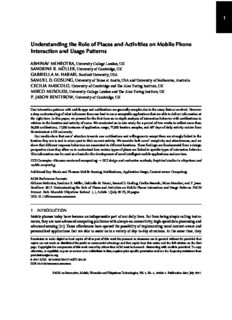Table Of Content1
Understanding the Role of Places and Activities on Mobile Phone
Interaction and Usage Paerns
ABHINAVMEHROTRA,UniversityCollegeLondon,UK
SANDRINER.MU¨LLER,UniversityofCambridge,UK
GABRIELLAM.HARARI,StanfordUniversity,USA
SAMUELD.GOSLING,UniversityofTexasatAustin,USAandUniversityofMelbourne,Australia
CECILIAMASCOLO,UniversityofCambridgeandeAlanTuringInstitute,UK
MIRCOMUSOLESI,UniversityCollegeLondonandeAlanTuringInstitute,UK
P.JASONRENTFROW,UniversityofCambridge,UK
Userinteractionpaernswithmobileappsandnoticationsaregenerallycomplexduetothemanyfactorsinvolved.However
adeepunderstandingofwhatinuencesthemcanleadtomoreacceptableapplicationsthatareabletodeliverinformationat
therighttime.Inthispaper,wepresentforthersttimeanin-depthanalysisofinteractionbehaviorwithnoticationsin
relationtothelocationandactivityofusers.Weconductedanin-situstudyforaperiodoftwoweekstocollectmorethan
36,000notications,17,000instancesofapplicationusage,77,000locationsamples,and487daysofdailyactivityentriesfrom
26studentsataUKuniversity.
Ourresultsshowthatusers’aentiontowardsnewnoticationsandwillingnesstoacceptthemarestronglylinkedtothe
locationtheyareinandinminorparttotheircurrentactivity.Weconsiderbothusers’receptivityandaentiveness,andwe
showthatdierentresponsebehaviorsareassociatedtodierentlocations.esendingsarefundamentalfromadesign
perspectivesincetheyallowustounderstandhowcertaintypesofplacesarelinkedtospecictypesofinteractionbehavior.
isinformationcanbeusedasabasisforthedevelopmentofnovelintelligentmobileapplicationsandservices.
CCSConcepts:•Human-centeredcomputing HCIdesignandevaluationmethods;Empiricalstudiesinubiquitousand
!
mobilecomputing;
AdditionalKeyWordsandPhrases:MobileSensing,Notications,ApplicationUsage,Context-awareComputing.
ACMReferenceformat:
AbhinavMehrotra,SandrineR.Mu¨ller,GabriellaM.Harari,SamuelD.Gosling,CeciliaMascolo,MircoMusolesi,andP.Jason
Rentfrow.2017.UnderstandingtheRoleofPlacesandActivitiesonMobilePhoneInteractionandUsagePaerns.PACM
Interact.Mob.WearableUbiquitousTechnol.1,1,Article1(July2017),22pages.
DOI:10.1145/nnnnnnn.nnnnnnn
1 INTRODUCTION
Mobilephonestodayhavebecomeanindispensablepartofourdailylives.Farfrombeingsimplecallinginstru-
ments,theyarenowadvancedcomputingplatformswithalways-onconnectivity,high-speeddataprocessingand
advancedsensing[21].eseaordanceshaveopenedthepossibilityofimplementingnovelcontext-awareand
personalizedapplicationsthatareabletoassistusinavarietyofday-to-daysituations.Atthesametime,they
Permissiontomakedigitalorhardcopiesofallorpartofthisworkforpersonalorclassroomuseisgrantedwithoutfeeprovidedthat
copiesarenotmadeordistributedforprotorcommercialadvantageandthatcopiesbearthisnoticeandthefullcitationontherst
page.CopyrightsforcomponentsofthisworkownedbyothersthanACMmustbehonored.Abstractingwithcreditispermied.Tocopy
otherwise,orrepublish,topostonserversortoredistributetolists,requirespriorspecicpermissionand/orafee.Requestpermissionsfrom
[email protected].
©2017ACM. 2474-9567/2017/7-ART1$15.00
DOI:10.1145/nnnnnnn.nnnnnnn
PACMonInteractive,Mobile,WearableandUbiquitousTechnologies,Vol.1,No.1,Article1.Publicationdate:July2017.
1:2 • Mehrotraetal.
(a) (b) (c) (d)
Fig.1. TheMyLifeLoggerapplication.
representauniqueplatformforreal-timedeliveryofinformationaboutavarietyofeventsrangingfromemails
toupdatesononlinesocialnetworks,fromadvertisementstopositivebehaviorchangeinterventions[5,20,31].
eadventofmobilesensinghasprovidedagreatopportunityforresearchersandpractitionerstoinvestigate
users’mobileinteractionbehavior.Mobileappsarenowcapableofrecordinginformationaboutusers’interactions
withmobilephonesandthesurroundingcontext(e.g.,location,activity,audioenvironment,andcollocationwith
otherdevices).ankstotheavailabilityofthisinformation,researchershavebeenabletoconductseveralstudies
onavarietyofaspectsofhuman-smartphoneinteraction.Forexample,studieshaveinvestigatedthediversityin
appusagebehaviorofindividuals[14],thecharacterizationofmobileusageinruralandurbansocieties[13]
orindierentsocio-economicgroups[32]. Othershavefocussedontheinuenceofpersonality[10,11],the
associationbetweensocialcontextandappusagepaerns[26],andusers’motivationsforusingdierenttypes
ofapps[18].Moreover,somestudieshavealsofocusedonunderstandingusers’appusagepaernsforpredicting
theirfutureinteractionwithapps[27,38].
Anotherparticularaspectthathasaractedtheaentionofresearchersgivenitspracticalimportanceisthe
characterizationofthereactionofuserstonoticationsandthedesignofmobilenoticationmanagementsystems.
Forexample,somestudieshaveinvestigatedthefactorsthatinuenceusers’aentivenessandreceptivityto
notications[24,30]andhowtheseareinuencedbycontext[28],content[23],andthecomplexityofanongoing
task[24].Otherprojectshaveaimedatanticipatingusers’aentiveness[30]andreceptivity[22]tonotications
bylearningtheirbehavioralpaerns.
However,existingworkhasnotconsideredtheimpactoftheexternalfactors,suchasthetypeoflocations
usersareinandtheactivitiestheyarecurrentlycarryingout,ontheirinteractionwithnoticationsandapp
usage behavior. A deep understanding of these factors would enable us to improve users’ experience and
the eectiveness of notications as well as applications (e.g., marketing and positive behavior intervention
applications). Keychallengesforsuchastudyincludedatacollectionataverynegranularity,whichmight
requirefrequentinputsfromusers,andtheextractionofhigh-levelinformationfromrawsensordatawiththe
goalofassigningsemanticstoit.
PACMonInteractive,Mobile,WearableandUbiquitousTechnologies,Vol.1,No.1,Article1.Publicationdate:July2017.
UnderstandingtheRoleofPlacesandActivitiesonMobilePhoneInteractionandUsagePaerns • 1:3
Tobridgethisgap,inthispaperwepresenttherstin-situstudyoftheimpactoflocationandactivitieson
users’interactionwithmobilenoticationsandapplications. Overaperiodoftwoweeks,wecollectedmore
than36,000notications,17,000instancesofapplicationusage,77,000locationsamples,and487daysofdaily
activityentries(i.e.,2984activityinstances)from26studentsataUKuniversity.Usingthisdata,weinvestigate
users’interactionwithmobilenoticationsandappswhentheyareperformingdierentactivities,whenthey
visitdierenttypesoflocations,andlocationswithdierentcharacteristicssuchasbeingboringvs.exciting,sad
vs.happy,inactivevs.busy,lazyvs.productive,distressingvs.relaxing,andnaturalvs.urban.
ekeycontributionsandndingsofthisworkcanbesummarizedasfollows:
Wediscussanin-depthstudyoftherelationshipsbetweenusers’activitiesandinteractionwithnotica-
•
tionsandapps.
Wediscussaquantitativeevaluationofusers’interactionwithnoticationsandappswhentheyareat
•
dierenttypesoflocations;thisisimportantfromadesignperspective,sinceitallowsustounderstand
howcertaintypesofplacesarelinkedtospecictypesofinteractionbehaviorasabasisofthedevelopment
ofintelligentapplications.
Wepresentanextensiveinvestigationoftheimpactoflocationcharacteristicsonusers’aentiveness
•
andreceptivitytonoticationsandappusagepaern.Weconsiderdierentcharacterizationofplaces
(e.g.,urban,productiveandsoon)inrelationtousers’interactionwithnotications.Again,besidesthe
inherentintellectualinterest,thendingsmightbeusedinthedesignofpersonalizedapplicationsbased
onlyontheknowledgeofthecurrentlocation.
roughouranalysisweuncovervariousnewinsightsaboutthephoneusageandnoticationinteraction
behaviorsofusersandalso,quiteimportantly,conrmsomendingsofpreviousstudies.Morespecically,the
mainnovelndingsofouranalysisare:
Participantsweremorereceptivetonoticationswhiletheywereexercisinganddoingroutinetasks.
•
Overallcommunicationappswereusedthemost,exceptwhileparticipantsweregoingtosleep,whichis
•
whentheymostlyusedlifestyleapps.
Participantsweremorereceptivetonoticationswhentheywereatcollege,inlibraries,onstreets,and
•
theywereleastaentivewhilebeingatreligiousinstitutions.
eappusagewashighestwhileparticipantswereatcollegeorinlibraries.
•
Participantsusedmostlymusicandreadingappswhilewaitingatbusstopsandtrainstations.
•
Participantsweremoreaentivetonoticationsatproductiveplacescomparedtolazyplaces.
•
Participantswerelessreceptivetonoticationsatnaturalplacescomparedtourbanplaces.
•
Whileatlazy,distressingandnaturalplacesparticipantsusedtheirphoneslesscomparedtoproductive,
•
relaxingandurbanplacesrespectively.
isstudyhasledtomanyinterestinginsightsthatarediscussedindetailinthefollowingsections.Firstof
all,peoplepaylessaentiontonoticationswhentheyarepreparingtogotobed(ortheyareinbedbefore
sleeping)andwhileexercising.Peopleacceptmostnoticationsthataredeliveredwhiletheyaredoingexercise
androutinetasks.Whenpeopleareonstreets,orincollege,universityandresidentialareas,theynotonlypay
moreaentiontowardsnoticationsbutalsoacceptmostofthem.Also,peoplearemoreaentivetonotications
atplacesthatarecharacterizedas“productive”.eyacceptmorenoticationsatproductiveandurbanplaces.
Furthermore,overallphoneusagedurationaswellasusageofspecicappsvarywhenpeoplevisitspecictypes
ofplacesandwhileperformingspecicactivities. Overallappusageishighestwhilepeoplearerelaxing,at
collegeorinlibraries,whereasitislowestwhilepeoplearedoingexercise,routinetasksorgoingtosleep,and
whentheyareatgyms,religiousinstitutionsorinparkingplaces.
Webelievethatthepotentialapplicationsofthisworkaremany. Firstofallthendingsofthispapercan
be used as a basis for the development of predictive applications that rely on the analysis of users’ current
PACMonInteractive,Mobile,WearableandUbiquitousTechnologies,Vol.1,No.1,Article1.Publicationdate:July2017.
1:4 • Mehrotraetal.
locationsandnotonlyontheirpastbehavioralpaerns.Morespecically,thisisparticularlyimportantinthe
bootstrappingphaseofintelligentapplicationsthatarebasedonlearningalgorithmsthatrequirealargehistory
ofpastinteractionswiththephonesinordertomakeaccuratepredictionaboutusers’behavior.Examplesinclude
noticationmanagementsystems,andpre-cachingandpre-launchingmechanismsformobileapplications.
2 RELATEDWORK
Inthissectionwereviewtherelatedworkintwokeyareas,namelythestudiesaboutthecharacterizationof
users’interactionwithnoticationsandthoseaboutusers’appusagebehavior.
2.1 UnderstandingUsers’InteractionwithNotifications
Inrecentyearstheareaofmobileinterruptibilityhasreceivedincreasingaention.Previousstudieshaveexplored
variousaspectsofusers’interactionwithmobilenotications[4,6,7,12,24,29,35].Inparticular,in[35]Sahami
etal.showthatusersdealwitharound60noticationsperday,andmostoftheseareviewedwithinafewminutes
ofarrival.Additionally,bycollectingthesubjectivefeedbackfrommobileusers,theauthorsdemonstratethat
usersassigndierentimportancetonoticationstriggeredbyapplicationfromdierentcategories.Atthesame
time,Pielotetal.[29]showthatpersonalcommunicationnoticationsarerespondedtoquickestbecauseofsocial
pressureandtheexchangeoftimecriticalinformationthroughcommunicationapplications(i.e.,Whatsapp).
Ontheotherhand, asIqbaletal. suggestin[19], usersarewillingtotoleratesomedisruptioninreturnfor
receivingnoticationsthatcontainvaluableinformation.Similarly,in[24]Mehrotraetal.showthatnotications
containingimportantorusefulcontentareoenaccepteddespitethedisruptioncausedbythem.
Moreover,otherstudieshavealsoinvestigatedhowusers’aentivenessandreceptivitytonoticationsare
inuencedbytheircontext[28,30]andcontent[16,22,23]. In[28],theauthorsshowthattheaentiveness
ofuserscanbedeterminedbycontextualfactorsincludingactivity,locationandtimeofday. eyproposea
mechanismthatreliesonthesecontextmodalitiestopredictopportunemomentsfordeliveringnotications.
In[30]Pielotetal.proposeamodelthatcanpredictwhetherauserwillviewanoticationwithinafewminutes
withaprecisionofapproximately81%. Ontheotherhand,in[16]theauthorsshowthatusers’receptivityis
inuencedbytheirgeneralinterestinthenoticationcontent,entertainmentvalueperceivedinitandaction
required by it, but not the time of delivery. In [23] Mehrotra et al. suggest to use contextual information,
sender-recipientrelationshipandapplicationcategorythattriggeredthenoticationfordeterminingtheuser’s
interruptibility.Inanotherstudy[22],theauthorsdemonstratethatusers’receptivitytonoticationsisinuenced
bytheirlocationandthecontentofnoticationsdelivered.eauthorsproposeasystemthatreliesonmachine
learningalgorithmsfortheautomaticextractionofrulesthatreectuser’spreferencesforreceivingnotications
indierentsituations.
2.2 UnderstandingUsers’AppUsageBehavior
Previous studies have investigated the association between users’ app usage behavior and various socio-
economic[13,14,32]andpsychological[10,11,26]factors.Othershavefocussedonusers’motivationsforusing
dierenttypesofapps[8,18].
Morespecically, in[32], Rahmatietal. presentastudythatinvestigateshowuserswithacertainsocio-
economicstatusinstallanduseapps.eirndingsconrmtheinuenceofsocio-economicstatusonphone
usage. In[11], theauthorsshowthatthereisasignicantassociationbetweenusers’personalitytraitsand
phoneusage.Furthermore,quiteinterestingly,in[18]Hinikeretal.provideevidencethatusers’motivationsfor
engagingwithtechnologycanbedividedintoinstrumentalandritualistic.
In[8],Bohmeretal. presentalarge-scalestudywiththegoalofunderstandingusers’appusagepaerns
basedontheircontext.endingsofthisstudydemonstratethatusersspendaroundanhoureverydayusing
theirphones,buttheiraveragesessionusinganapplicationlastsforaminute.Overall,communicationappsget
PACMonInteractive,Mobile,WearableandUbiquitousTechnologies,Vol.1,No.1,Article1.Publicationdate:July2017.
UnderstandingtheRoleofPlacesandActivitiesonMobilePhoneInteractionandUsagePaerns • 1:5
Group Feature Description
Arrivaltime Timeatwhichanoticationarrivesinthenoticationbar.
Removaltime Timeatwhichanoticationisremovedfromthenoticationbar.
Notication
Senderapplication Nameandpackageoftheapplicationthattriggersthenotication.
AppName Nameoftheapplication.
ApplicationUsage LaunchTime Timeatwhichtheapplicationislaunchedandappearedintheforeground.
BackgroundTime Timeatwhichtheapplicationuseisendedanditismovedfromforeground
tobackground.
Lock/unlockevent Timeatwhichthephonewaslockedandunlocked.
PhoneInteraction
Screeninteraction Typeofinteraction(i.e.,singleclick,longclickandscroll),timeandthename
offoregroundapplications(includinghomescreen)withwhichtheinteraction
happened.
Location Geo-locationoftheplacesvisited.
Context DailyActivity Typeandtimedurationofdierentactivitiesperformedinaday.eseactiv-
itiesincludesleep,eat,work,physicalexercise,socialactivityandrelaxation.
Table1. Descriptionoffeaturesfromthedataset.
usedmost,exceptwhenusersaretraveling,inwhichcasetheyaremorelikelytousemultimediaapps.In[15],
Ferreiraet.al.conductedastudyshowingthatappusagebehaviorofusersisstronglyinuencedbytheirsocial
andspatialcontext. Also,Xuetal.[37]exploitthenetworktracfromapps(basedonHTTPsignatures)to
demonstratethatappusageisinuencedbyspatialandtemporalfactorsincludinggeographicalareasandtime
oftheday.eirndingsalsoshowthatcertainappshaveanonnegligiblelikelihoodofco-occurrence.
An open question in this area remains the impact of locations and activities on users’ interaction with
notications. epresentstudyaimstobridgethisgapbyinvestigatingtheeectsofthesefactorsonusers’
aentivenessandreceptivitytonoticationsaswellasontheirappusagebehavior.
3 METHODOLOGY
Inthissectionwepresentourapproachforinvestigatingtheinuenceofdailyactivities,typeandcharacteristics
ofvisitedlocationsonusers’appusage,andnoticationinteractionbehavior.
3.1 LifeLoggerApp
Giventheaimsoftheproposedinvestigation,wedesignedandcarriedoutanin-the-wild study[34]tocollect
users’data.Morespecically,wedevelopedanAndroidappcalledMyLifeLogger (showninFigure1).eapp
performs continuous sensing in the background to log users’ interaction with notications, app usage, and
context.Table1providesadescriptionofthefeaturescapturedbyMyLifeLogger.
eappreliesonAndroid’sNoticationListenerService[1]andUsageStatsManager[2]totracenotications
andapplicationusage. Moreover, theappallowsuserstoprovidetheirdailyactivityschedules, forwhicha
remindernoticationistriggeredeverynightat9pm(localtime).AsshowninFigure1(b),usersweregivenalist
ofsixpossibledailyactivities:
Eat:timeperiodwhenauserishavingfood.
•
Sleep:timeperiodforwhichauserslept.1
•
Work:timeperiodwhenauserisengagedinanactivityinvolvingmentalorphysicaleort.Sinceour
•
participantsarestudents,thisactivitywouldmostlyconsistoforberelatedtostudying.
1Itisworthnotingthatparticipantsdidnotreceiveanystandarddenitionoftheseactivitiesbeforethestudy.erefore,forexample,some
participantsmighthaveinterpretedsleepingasbeinginbed.
PACMonInteractive,Mobile,WearableandUbiquitousTechnologies,Vol.1,No.1,Article1.Publicationdate:July2017.
1:6 • Mehrotraetal.
Exercise:timeperiodwhenauserisperforminghealthandtnessactivities.
•
Social:timeperiodwhenauserissocializingwithothers.
•
Relaxation:timeperiodduringwhichauserisbeingfreefromtensionandanxiety.
•
Itisworthnotingthatparticipantswereabletoselectonlyoneactivityforaspecictimeinterval.Moreover,
theywereallowedtoenterotheractivitiesbyselectingtheother option,throughwhichtheycouldinputan
activitynameasfreetext. Mostactivitiesregisteredthroughtheother activityoptionwererelatedtoroutine
taskssuchaslaundry,cooking,geingready,packing,supermarketandsoon.erefore,wecreatedanother
categoryforchoresandmappedtheroutinetasksenteredthroughtheother activityoptiontothisnewactivity.
eMyLifeLoggerappalsocollectedadditionaldataaboutothercontextualfeatures(suchasmovement,call
andSMSlogs)aswellasmood-relatedquestionnaires. However,wedonotdiscussthoseaspectsofthedata
becausetheyarenotusedfortheanalysispresentedinthispaper.
3.2 RecruitmentoftheParticipants
MyLifeLoggerwaspublishedonGooglePlayStore2andadvertisedtorst-yearundergraduatestudentsataUK
University.Itwasinstalledby28studentsand26studentscompletedthestudybykeepingtheapprunningon
theirphoneforaminimumoftwoweeks.eseparticipantscomefrombothsexes(16malesand10females),
withtheagespanbetween18and27years(mean =19.46andstandardde�iation =2.18). estudentswere
enrolledin15dierentcoursesand27%(n=7)werenon-British.Allparticipantswhocompletedthestudywere
given£25.
3.3 EnsuringPrivacyCompliance
InordertoallowtheMyLifeLoggerapplicationtomonitornoticationsandappusage,theuserhastogiveexplicit
permissionasrequiredbytheAndroidoperatingsystem.Moreover,theapplicationalsoshowsaconsentform
detailingtheinformationthatiscollected.isensuresthattheusergoesthroughatwo-leveluseragreement
andiscompletelyawareofthetypeofinformationcapturedbytheapplication.
Itisworthnotingthatwereceivedethicalapprovalforthestudy,includingallproceduresandmaterials,from
thePsychologyResearchEthicsCommieeattheUniversityofCambridge.
3.4 Dataset
Weanalyzedthedataof26userswhoparticipatedforaminimumperiodoftwoweeks.edatasetcorresponding
totheseusersincludes36,106notications,17,680instancesofapplicationusage,77,306locationsamples,and
487daysofdailyactivityentries(i.e.,2,984activities).
3.4.1 CharacterizingLocations. Inordertoperformouranalysisontheimpactoflocationonnotication
responseandapplicationusage,wecannotjustrelyonsensor(i.e.,GPS)dataasitonlyprovidesthecoordinates
ofaplaceratherthanitstypeandcharacteristics.erefore,wemanuallycategorizedthelocationsbyclustering
themintosignicantplaces,andthencharacterizedthesignicantplacesbyhavingcodersrateeachplaceon
severaldimensions(e.g.,thedegreetowhichaplaceisinactivevsbusy).
IdentifyingSignicantPlaces.Firstofall,wediscardthelocationsampleswithmorethan50metersaccuracy
sothattheestimatedlocationclustersareofbeerquality.Wethenndthelocationsamplesthatwerecollected
whileusersweremovingandwealsodiscardthem.Inordertoinfersuchlocationpoints,wecomputethespeed
oftheuserbyusingthedistanceandthetimebetweenthelastandthecurrentlocationpoints.Ifthespeedis
2hps://play.google.com/store/apps/details?id=com.nsds.mystudentlife
PACMonInteractive,Mobile,WearableandUbiquitousTechnologies,Vol.1,No.1,Article1.Publicationdate:July2017.
UnderstandingtheRoleofPlacesandActivitiesonMobilePhoneInteractionandUsagePaerns • 1:7
lessthanacertainthreshold(i.e.,5kmperhour)weconsiderthatlocationreadingwascollectedwhentheuser
wasnotmoving.
Now,weusethelocationclusteringapproachpresentedin[36]forgroupingthelteredlocationsamples.We
iterateoveralllocationsamplesandforeachlocationpointwecreateanewclusteronlyifthedistanceofthis
locationfromthecentroidofeachexistingclusterismorethan200meters.Otherwise,weaddthislocationto
thecorrespondingclusterandupdateitscentroid.Finally,weconsiderallcentroidsassignicantplaces.
IdentifyingPlaceTypeandCharacteristics.Placescanbedescribedintermsofobjectiveinformation,such
aswhetheralocationisindoororoutdoor,orinaresidentialorindustrialarea,andalsointermsofinformation
thatrelatestousers’aectiveappraisalsofthem.Despitepeople’sexperiencesofcoursebeingsubjective,they
on average agree on a variety of characteristics such as liveliness, pleasantness, and naturalness, to name a
few[17,25].Atthesametime,werecruitedcodersbelongingtothesamedemographicsoftheparticipants(e.g.,
studentstatus,averageage,evengenderdistribution)toreducethesubjectivenessinplaceratings.Moreover,we
computedthesimilarityintheratingstoensurethattheyarereliable.
Onaverage,53signicantplaces(perperson)wereidentiedinthetwo-weekstudyperiod.Foreachparticipant
weselectedthetoptenplacesinwhichtheyhadspentmosttime.Werecruitedfourindependentcoderswho
wereundergraduatestudentsthemselvesbutnotparticipantsinthestudy.First,theyweretrainedinpersonand
providedwithadetailedhandbookonthelocationcodingprocess.Aertheirtraining,theywereprovidedwith
alistofcoordinates(i.e.,longitudeandlatitude)oftherespectiveplaces,andtheywereaskedtocategorizeand
evaluatetheseplacesforthegivencharacteristicsbylookingatthemusingGooglemaps.
Inordertocategorizetheplacetype,werelyonGoogle’sPlaceTypes[3]asthepossiblecategories.Moreover,
coderswereprovidedwithanoptiontoenteranadditionalplacetypeincaseitwasnotpresentinthegivenlist.
Incaseswhereaplacetypewasunclear,codersusedan“unclear”categorytodenoteanambiguousplace.Finally,
eachplacetypethatwasclassiedbyfourcoderswasmergedbyoneoftheauthors.Itisworthnotingthatwe
lteredoutthecategoriesthatappearedrarelyornotatall.Inordertoperformthisltering,weensuredthat
placesofeachcategorywerevisitedatleastoncebyaminimumof50%oftheparticipants.
Inordertoidentifythecharacteristicsofsignicantplaces,thesewerealsocodedfor24descriptivecharacter-
isticsthatcapturedtheambienceoftheplace,andthetypesofpeoplethatwouldvisittheplace.Inthiswork,we
focusedonthefourcharacteristicratingsthatdescribetheambianceoftheplace.Specically,wefocusedonthe
degreetowhichtheplacewas:inactive-busy,lazy-productive,distressing-relaxing,andnatural-urban.esefour
characteristicswereratedona7-pointLikertscale. eseratingsfromthefourcoderswerethenmergedby
computingtheirmean. Finally,themergedratingswerecenteredandrescaledfroma1to7scaletoa-3to3
scale.Wethentransformthesefroma7-pointscaletoa3pointsscale(-1to1)byusingtheseranges:-3to-0.5as
-1,-0.5to0.5as0,and0.5to3as1.isturnedthecontinuousvariableintoacategoricaloneandmakesitlikely
thatwehaveenoughdataforalllevels.Levels 1,0,1representthenegative,neutral,andpositivevalueofthe
�
locationcharacteristicrespectively.Forinstance,theseratingsforinactive-busycharacteristicswouldconvertto
inactive,neutralandbusy.
3.4.2 AppCategories. Inordertoinvestigateusers’behaviorforinteractingwithspecicapps,wecategorized
all apps using the categories dened on the Google Play store. Overall, the apps belong to 11 categories,
namelyreading,tness,business,photography,communication,game,lifestyle,music,social,tools,andtravel
applications. However,appsofcertaincategoriesarenotusedbyallparticipants. erefore,weconsiderthe
typeofappsthatwereusedbyallparticipants. Consequently,wecameupwiththefollowingsixcategories:
communication,lifestyle,music,reading,social,andtravelapplications.
PACMonInteractive,Mobile,WearableandUbiquitousTechnologies,Vol.1,No.1,Article1.Publicationdate:July2017.
1:8 • Mehrotraetal.
3.5 antitativeMeasuresforNotificationandPhoneUsage
In this section we discuss the metrics used in this study for quantifying users’ behavior in terms of their
interactionswithnoticationsandapps. Weusetwometricsforquantifyinginteractionwithnotications–
NoticationReceptivityandNoticationSeenTime,andonemetricforinteractionwithapp–AppUsageTime.
eseareclassicindicatorswidelyadoptedforthistypeofstudiesbytheubiquitouscomputingcommunity(see
forexample[16,30]).edenitionsofthesemetricsarereportedbelow.
NoticationReceptivity:theuser’swillingnesstoreceiveanotication.ismetricrepresentshow
•
willingauseristoreceiveinterruptions. Highreceptivity(i.e.,moreclicks)indicatesincreaseinthe
willingnessoftheusertobeinterruptedandviceversa.Inordertoinfertheresponsetoanotication,we
checkwhetherthecorrespondingapp(whichtriggeredthenotication)waslaunchedaertheremoval
timeofthatnotication.Weareawarethatourapproachhaslimitations,becausesomenoticationsthat
donotrequirefurtheractionmightnotbeclickedratherjustseenanddismissedbytheuser.
NoticationSeenTime(NoticationAttentiveness):thetimefromthenoticationarrivaluntilthe
•
time the notication was seen by the user. is metric reects the user’s aentiveness towards new
notications.Inordertodetectthemomentatwhichanoticationisseen,weusetheunlockeventof
thephoneandassumethatallnewlyavailablenoticationsinthenoticationbarareseenwhentheuser
unlocksthephone.Incaseanoticationarriveswhentheuserisalreadyusingthephone(i.e.,thephone
isunlocked),theseentimeofthisnoticationwouldbeconsideredequaltozero.Todetectthelockand
unlockeventsweusethePhoneInteractiondata(discussedinTable1).Itisworthnotingthatweremoved
allnoticationinstancesthatwerenotrespondedtowithin2hours.Asarecentstudy[29]demonstrated
thatpeoplereceivenoticationseveryhour(frommorningtolatenight),whicharehandledwithinafew
minutes.erefore,weuse2-hourthresholdforthemaximumseentimetolteroutnoticationsthat
arrivedwhentheuserwasawayfromthephoneorsleeping.
AppUsageTime:durationforwhichanapplicationwasinforeground.Morespecically,itisthetime
•
intervalbetweenthelaunchofanapplicationandtheinstantoftimewhenitwassenttothebackground.
We compute these metrics for each user when they are performing specic activities and when they are
atcertaintypesofplaces. Wethenaggregatethesemetricstocomputetheiraveragevalues. Finally,weuse
statisticalteststocomparethedierenceinusers’interactionwhenperformingdierentactivitiesatdierent
typesofplaces.
ItisworthnotingthatwhilecomputingAppUsageTimefordierentactivities,wenormalizetheappusage
valuebydividingitbythetimespentbytheuserengaginginthecorrespondingactivity.Similarly,tocompute
theAppUsageTimefordierenttypesofplaces,wenormalizetheappusagevaluebydividingitbythetime
spentbytheuseratthecorrespondingplace.isstepisnecessaryinordertoavoidbiasesduetotherelative
timesspentinagivenlocationorwhileengaginginacertainactivity.erefore,theuseofanon-normalized
AppUsageTimemetriccouldproducebiasedresults.
3.6 Procedure
Wewanttoinvestigatetheinuenceofvariables,includingdailyactivities,typeandcharacteristicsofvisited
locations,onthenoticationandphoneusagebehaviorofusers,soweconsiderthemastheindependentvariables.
Ontheotherhand,ourdependentvariablesshouldrepresentthenoticationandphoneusagebehaviorofusers.
erefore,weusethethreenoticationandphoneusagemetrics(NoticationReceptivity,NoticationSeenTime,
andAppUsageTime)asdependentvariables. eanalyseswereperformedforeachpairofindependentand
dependentvariables.Weperformaone-wayANOVAforquantifyingthedierencesinthedependentvariables
(i.e.,NoticationReceptivityandNoticationSeenTime)thatrepresentsnoticationinteractionbehavior.However,
forquantifyingthevariabilityinthedependentvariable(i.e.,AppUsageTime)thatrepresentappusagebehavior,
PACMonInteractive,Mobile,WearableandUbiquitousTechnologies,Vol.1,No.1,Article1.Publicationdate:July2017.
UnderstandingtheRoleofPlacesandActivitiesonMobilePhoneInteractionandUsagePaerns • 1:9
ANOVA (p<0.05) 90 ANOVA (p<0.05)
40
Seen Time (mins)123000 ● ● Receptivity (%)678000 ● ● ● ● ● ●
● ● ● ● ● 50 ●
0
work sleep chores relaxation social eat exercise work sleep chores relaxation social eat exercise
Daily Activity Daily Activity
(a) (b)
Fig.2. Roleofdailyactivityininfluencingtheuser’s(a)aentivenessand(b)receptivity.Dierentcolorindicatesstatistically
significantdierences(p<0.05).Intheseplotsthedotsrepresentthemeansandthebarsrepresentthestandarddeviations.
Activity work chores social exercise Activity work chores social exercise
sleep relaxation eat sleep relaxation eat
0.08
0.015
0.06
Density0.04 Density0.010
0.02 0.005
0.00 0.000
0 25 50 75 0 25 50 75 100
Seen Time (mins) Receptivity
(a) (b)
Fig.3. Probabilitydistributionsofusers’average(a)aentivenessand(b)receptivitywhileperformingdierentdailyactivities.
Here,probabilitiescanbecomputedasmultiplicationofdensitywithaentivenessandreceptivityvaluesrespectively.
weperformatwo-wayANOVA,becauseappcategoryisconsideredasanotherindependentvariableapartfrom
activityandlocationbasedindependentvariables.Itisworthnotingthatweremovedthelevelsofindependent
variablesthatdidnothaveobservationsfromatleast50%oftheparticipants.
4 UNDERSTANDINGTHEROLEOFDAILYACTIVITY
Inthissectionweprovideaquantitativeevaluationoftherelationshipbetweendailyactivityandtheusers’
behaviorintermsofnoticationinteractionandappusage.
ekeyndingsofthissectionare:
Peopleareleastaentivetonoticationswhiletheyarepreparingtogotobed(orusingthephone
•
inbed)andduringthetimetheyexercise.
Peoplearemorereceptivetonoticationswhiletheyareexercisinganddoingchores(i.e.,routine
•
tasks).
Overallappusageishighestwhilepeoplearerelaxingandlowestwhentheyareengagedinchores,
•
doingexerciseandgoingtosleep.
Usageofspecicappsisassociatedtousers’dailyactivities.
•
PACMonInteractive,Mobile,WearableandUbiquitousTechnologies,Vol.1,No.1,Article1.Publicationdate:July2017.
1:10 • Mehrotraetal.
Application Category
● communication ● lifestyle ● music ● reading ● social ● travel
ANOVA
App Category (p<0.05)
%)3 ● Daily Activity (p<0.05)
me ( ● ● Interaction (p<0.05)
Ti
e 2 ●
g
a
s ●
pp U1 ● ● ● ● ● ● ●● ●
A0 ● ● ● ●●● ● ● ●●●● ●●● ● ●●●●● ● ● ●●●●●
work eat sleep social chores relaxation exercise
Daily Activity
Fig.4. Relationbetweendailyactivityandapplicationusage.Inthisplotthedotsrepresentthemeansandthebarsrepresent
thestandarddeviations..
4.1 AentivenessandReceptivity
Toinvestigatetherelationshipbetweendailyactivityandusers’aentivenessandreceptivitytonotications,
weperformtwoseparateone-wayANOVAsthatquantifythedierencesintheuser’s(i)aentivenessand(ii)
receptivitytonoticationswhiletheyperformdierentactivities.eresultsoftherstanalysis(i.e.,eects
onaentiveness)showthatthereisasignicanteectofdailyactivitiesontheuser’saentiveness,withF =
4.788,p <0.05.Inordertondwhichdailyactivitiesaectusers’aentiveness,weperformaTukeypost-hoc
test(byseing� equalto0.05).AsshowninFigure2(a),thetestrevealsthattheseentimeislongest(i.e.,low
aentiveness)whennoticationsarrivewhiletheuserissleeping.However,thereisnosignicantdierence
inaentivenessofuserswhiletheyareengagedinanyotherdailyactivity,exceptthattheyareslightlyless
aentivewhileexercising.
eresultsofthesecondanalysisshowthatthereisalsoasignicanteectofdailyactivitiesontheusers’
receptivitytonotications,withF =2.947,p <0.05.AsshowninFigure2(b),aTukeypost-hoctest(byseing�
equalto0.05)revealsthatusers’aremostreceptivetonoticationswhentheyareperformingchoresorphysical
exercisecomparedtootheractivities.
Moreover,inordertoinvestigatethediversityinusers’aentivenessandreceptivity,inFigure3wepresentthe
probabilitydistributionofusers’averageaentivenessandreceptivitywhiletheyareperformingdierentdaily
activities.eresultsdemonstratethatthereissomevariabilityinbothaentivenessandreceptivitybetween
users.Forinstance,someusersareconsiderablylessaentivetonoticationswhileexercisingcomparedtoother
users.Users’receptivityvariesacrossallactivities.
4.2 AppUsageTime
Inordertoinvestigatetherelationshipbetweendailyactivitiesandtheappusage,weperformatwo-wayANOVA
byseingappusagetimeasdependentvariable(DV),anddailyactivityandappcategoryasindependentvariable
(IVs). Here,weusetwoIVsaswecanquantifyboththeeectofdailyactivityonoverallappusagetimeand
theeectofdailyactivityoftheuseofspecicapps.eresultsdemonstratethatalleectswerestatistically
signicantatthe0.05signicancelevel.emaineectfordailyactivityyieldedF =7.45(p <0.05),indicatinga
signicantdierenceintheuser’soverallappusagetime(allcategoriesconsideredtogether)whileperforming
PACMonInteractive,Mobile,WearableandUbiquitousTechnologies,Vol.1,No.1,Article1.Publicationdate:July2017.
Description:Understanding the Role of Places and Activities on Mobile Phone . Participants used mostly music and reading apps while waiting at bus stops and train stations. locations and not only on their past behavioral pa erns.

